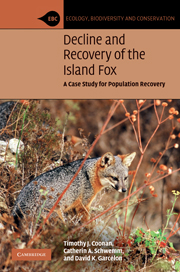Book contents
- Frontmatter
- Contents
- Foreword
- Acknowledgments
- 1 Introduction
- 2 Evolution and genetics
- 3 Social structure, reproduction, mortality and survivorship, and population dynamics
- 4 Food habits, habitat use, activity patterns, and dispersal
- 5 Golden eagles and the decline on the northern islands
- 6 Ecosystem recovery
- 7 Disease and decline on Santa Catalina Island
- 8 Recovery actions
- 9 Recovery actions
- 10 Reproductive biology, by Cheryl Asa
- 11 Diseases of island foxes, by Linda Munson
- 12 Zoos, education, and public participation
- 13 Managing recovery
- 14 The ecological role of island foxes
- 15 Conclusion
- References
- Index
1 - Introduction
Published online by Cambridge University Press: 05 October 2010
- Frontmatter
- Contents
- Foreword
- Acknowledgments
- 1 Introduction
- 2 Evolution and genetics
- 3 Social structure, reproduction, mortality and survivorship, and population dynamics
- 4 Food habits, habitat use, activity patterns, and dispersal
- 5 Golden eagles and the decline on the northern islands
- 6 Ecosystem recovery
- 7 Disease and decline on Santa Catalina Island
- 8 Recovery actions
- 9 Recovery actions
- 10 Reproductive biology, by Cheryl Asa
- 11 Diseases of island foxes, by Linda Munson
- 12 Zoos, education, and public participation
- 13 Managing recovery
- 14 The ecological role of island foxes
- 15 Conclusion
- References
- Index
Summary
To the hiker it was a subtle change to the landscape, but nearly overwhelming in its implications. On the trail were small fox tracks, simple footprints made casually as the animal walked, probably quickly but not necessarily in a hurry. Animals often use human trails to conserve energy while traveling, so the observation of the prints was not in itself surprising. It was the simple existence of the tracks that made the hiker stop, look around, and smile inwardly at the thought; island foxes were again roaming the wilderness of San Miguel Island.
Island foxes are a unique species of small carnivore that live only on the Channel Islands located off the coast of Southern California in the United States of America. The California Channel Islands consist of eight islands, four in the northern group and four in the southern group. Of the eight, three in the north – Santa Cruz, Santa Rosa, and San Miguel – and three in the south – San Nicolas, San Clemente, and Santa Catalina – support populations of island foxes, and on each island a unique subspecies has evolved:
San Miguel Island fox: Urocyon littoralis littoralis;
Santa Rosa Island fox: Urocyon littoralis santarosae;
Santa Cruz Island fox: Urocyon littoralis santacruzae;
San Nicolas Island fox: Urocyon littoralis dickeyi;
Santa Catalina Island fox: Urocyon littoralis catalinae;
San Clemente Island fox: Urocyon littoralis clementae.
San Miguel and Santa Rosa Islands are managed by the National Park Service (NPS), Santa Cruz is co-managed by the National Park Service and The Nature Conservancy, Santa Catalina is managed by the Catalina Island Conservancy, and San Nicolas and San Clemente are managed by the US Navy (Fig. 1.1).
- Type
- Chapter
- Information
- Decline and Recovery of the Island FoxA Case Study for Population Recovery, pp. 1 - 4Publisher: Cambridge University PressPrint publication year: 2010



